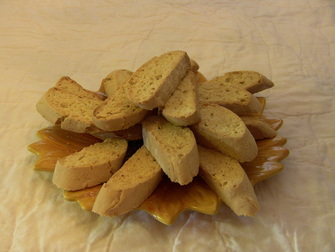Biscotti Recipes
Anise Biscotti and Variations

These are crisp biscotti with the wonderful flavor of anise. Because they are crisp and not tooth breaking hard like the traditional cantucci from Tuscany, they are perfect to serve with coffee or tea, and they do not need to be dunked to enjoy them. Of course, they are also good served in the traditional manner with a dessert wine such as vin santo or passito. I like to eat them for breakfast or as a mid-afternoon snack. If the flavor of anise is not your thing, try one of the variations below with lemon or cinnamon and sugar or chocolate chips.
About Biscotti
Biscotti, in America we use the term to mean a certain type of Italian cookie; however, in Italy, the term actually is the generic term for cookies. In Italy, what Americans know as biscotti is named cantucci, and in Tuscany it is traditionally made with almonds; however, each region has its own variation. The traditional cantucci is generally very hard and served with a sweet wine either a vin santo or a passito for dipping.
Based on my experience with cantucci in Italy, I had never really thought about making them. However, one day, several years ago my Italian friend, Gianni whom I regularly consulted to judge the authenticity of my Italian dolci, said, "Why don't you make some biscotti." Well, okay the gauntlet was thrown down, and I had to try to make this now ubiquitous treat. Since that day, I have made biscotti more times than I can count and with many different flavorings. It is always a hit weather I make it in California or in Italy. I was particularly pleased a few months ago when I took some of my anise biscotti to an Italian friend's home here in Le Marche, Italy where we were invited for dinner. Her aunt, an Italian Nonna (grandmother), who was among the dinner guests ate several, and told me many times how good they were. So, now I had the official Nonna stamp of approval.
For these biscotti, as well as a majority of my dolci recipes, I substitute olive oil for butter. I use extra virgin olive oil, but not all extra virgin olive oil is the same. Here in Le Marche, I can choose among a number of small, local oil producers to pick the right one. You do not want an oil that is peppery or too strong in flavor. In America, I have found that oils from Liguria are very light and fruity in flavor and work very well in dolci recipes.
Ingredients
¼ cup olive oil (Extra virgin works great in this recipe. Use a light fruity EVO.)
2/3 cup of sugar (preferably a fine, highly soluble sugar)
1 teaspoon vanilla extract
1 egg plus one egg yolk
1 1/2 teaspoons baking powder
2 cups all purpose flour (approximately)
1 tablespoon anise seeds
Equipment
1 baking sheet covered with parchment paper
kitchen aid or hand mixer
Making the Biscotti
Step 1: Preheat oven to 350 degrees.
Step 2: In a mixing bowl, combine the olive oil and sugar and mix for 1 to 2 minutes. (I use the kitchen aid for steps 2-4. But be aware that by the time you add the last of the flour your mixer may be laboring hard because of the viscosity of the dough.)
Step 3: Add the egg and egg yolk, baking powder, anise seeds, and vanilla to the oil and sugar mixture and mix thoroughly.
Step 4: Add one cup of flour to the mixture and mix until it is fully integrated with the oil mixture. Now add about 2/3 of the remaining cup of flour and mix well. Depending on the size of your eggs, you may need to use the entire 2 cups of flour, but it is possible that you will use less. Your dough should remain a little sticky, but not so sticky that you can not handle it, Add more of the flour if needed.
Step 5: Transfer the dough from the mixing bowl to a well floured surface. As the dough will still be a little sticky, knead it for about 1 minute on the floured surface forming it into a round.
Step 6: Cut the round of dough into two equal pieces and roll each half of the dough by hand into a log shape. Your log will be approximately 9 - 10 inches in length. Transfer the log to your baking sheet and pat down the top of each log slightly.
Step 7: Bake in a 350 degree oven for approximately 20 minutes until the logs are starting to brown on top and are somewhat firm to the touch.
Step 8: Remove the logs from the oven and let cool for approximately 15 to 20 minutes. When the logs are cool, cut them into diagonal slices about ¾ of an inch in thickness. (I find this works better if I do not use a serrated knife, but many recipes suggest using a serrated knife. Try both and see what works best for you.)
Step 9: Place the sliced biscotti back on the baking sheet and return to the oven for approximately 12 minutes turning each biscotti over after 7 minutes. Biscotti should take on a lightly golden brown appearance.
Step 10: Remove the biscotti from the oven, let cool and enjoy. Biscotti will keep well in an airtight container for several days.
Recipe yields approximately 22-24 biscotti.
A few simple variations
1. Instead of using vanilla and anise, substitute lemon with the anice.
2. Eliminate the vanilla and anise and use one teaspoon of lemon extract and one tablespoon of lemon zest.
3. Eliminate the anise and add one or one and a half teaspoons of cinnamon, to taste. Before putting the biscotti in the oven to bake for a second time, sprinkle generously with a cinnamon and sugar mixture made of 1 tablespoon of cinnamon and 3 tablespoons of sugar. Do not turn the biscotti over while baking.
4. Eliminate the anise and add 1/2 cup of small chocolate chips and some slivered almonds, if desired.
